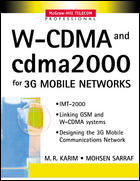W-CDMA Mobile Communication Systems
暫譯: W-CDMA 行動通信系統
Keiji Tachikawa
- 出版商: Wiley
- 出版日期: 2002-09-17
- 售價: $1,080
- 貴賓價: 9.8 折 $1,058
- 語言: 英文
- 頁數: 434
- 裝訂: Hardcover
- ISBN: 0470847611
- ISBN-13: 9780470847619
-
相關分類:
行動通訊 Mobile-communication
已絕版
買這商品的人也買了...
-
 計算機組織與設計--軟硬體界面第二版 (Computer Organization & Design, 2/e)
計算機組織與設計--軟硬體界面第二版 (Computer Organization & Design, 2/e)$680$537 -
 Data Mining: Concepts and Techniques
Data Mining: Concepts and Techniques$2,520$2,394 -
 Oracle 9i 資料庫管理指南
Oracle 9i 資料庫管理指南$480$408 -
 Dreamweaver MX 中文版魔法書
Dreamweaver MX 中文版魔法書$490$417 -
 Understanding the Linux Kernel, 2/e (Paperback)
Understanding the Linux Kernel, 2/e (Paperback)$1,800$1,710 -
 C++ Builder 6 完全攻略
C++ Builder 6 完全攻略$690$587 -
 PHP & MySQL 完全架站攻略第二版
PHP & MySQL 完全架站攻略第二版$620$527 -
 學 UML 的第1本書
學 UML 的第1本書$280$218 -
 Linux C/C++ 網路程式設計
Linux C/C++ 網路程式設計$450$383 -
 Java 完美經典優質學習篇
Java 完美經典優質學習篇$750$638 -
 系統程式 (System Software: An Introduction to Systems Programming, 3/e)
系統程式 (System Software: An Introduction to Systems Programming, 3/e)$600$588 -
 Red Hat Linux 9 實務應用
Red Hat Linux 9 實務應用$650$553 -
 802.11 無線網路技術通論 (802.11 Wireless Networks: The Definitive Guide)
802.11 無線網路技術通論 (802.11 Wireless Networks: The Definitive Guide)$760$600 -
 Dreamweaver MX 互動網站百寶箱 for ASP
Dreamweaver MX 互動網站百寶箱 for ASP$580$493 -
 ASP.NET 程式設計徹底研究
ASP.NET 程式設計徹底研究$590$466 -
 Building Embedded Linux Systems
Building Embedded Linux Systems$1,650$1,568 -
 STRUTS 實作手冊(Struts in Action: Building Web Applications with the Leading Java Framework)
STRUTS 實作手冊(Struts in Action: Building Web Applications with the Leading Java Framework)$690$538 -
 深入淺出 JBuilder 程式設計實作(JBuilder 9.0/8.0/7.0 適用) (Charlie Calvert's Learn Jbuilder)
深入淺出 JBuilder 程式設計實作(JBuilder 9.0/8.0/7.0 適用) (Charlie Calvert's Learn Jbuilder)$720$562 -
 重構─改善既有程式的設計
重構─改善既有程式的設計$720$569 -
 行動 Linux─KNOPPIX 改造手冊
行動 Linux─KNOPPIX 改造手冊$290$247 -
 Effective Java Programming Language Guide 中文版 (Effective Java Programming Language Guide)
Effective Java Programming Language Guide 中文版 (Effective Java Programming Language Guide)$560$442 -
 LDAP 系統管理 (LDAP System Administration)
LDAP 系統管理 (LDAP System Administration)$620$490 -
 鳥哥的 Linux 私房菜-伺服器架設篇
鳥哥的 Linux 私房菜-伺服器架設篇$750$638 -
 鳥哥的 Linux 私房菜─基礎學習篇增訂版
鳥哥的 Linux 私房菜─基礎學習篇增訂版$560$476 -
![The World Is Flat [Updated and Expanded]: A Brief History of the Twenty-first Century (平裝)-cover](https://cf-assets2.tenlong.com.tw/products/images/000/030/029/medium/51TZGXhkUfL.jpg?1540679770) The World Is Flat [Updated and Expanded]: A Brief History of the Twenty-first Century (平裝)
The World Is Flat [Updated and Expanded]: A Brief History of the Twenty-first Century (平裝)$480$456
相關主題
商品描述
- Reviews various cellular systems, describes their characteristics and discusses the objectives of IMT-2000 and the status of standardization
- Explains the mechanisms and characteristics of CDMA with respect to radio access systems and describes basic transmission and capacity enhancement technologies
- Provides a detailed explanation of radio access interfaces and radio systems designs and an introduction to mobile terminals
- Discusses ATM technologies, packet communication systems and other types of network systems
- Provides an outline of network control and equipment monitoring and administration
- Describes the multimedia signal processing technologies, systems for distributing information and processing location information and electronic authentication systems
- Forecasts the mobile radio systems and network for the future
Written with researchers, developers and operators in the mobile communications sector in mind, as well as students and end users, W-CDMA Mobile Communications System will enable a wide range of readers to gain a thorough understanding of W-CDMA.
Table of Contents
Editorial Board.
Supervisor's Note.
Preface.
Chapter 1: Overview (K. Suwa, et al.).
Generation Change in Cellular Systems.
Overview of IMT-2000
Chapter 2: Radio Transmission Systems (M. Sawahashi).
Direct Sequence Code Division Multiple Access (DS-CDMA).
Basic W-CDMA Transmission Technologies.
Link Capacity Expansion Technologies in W-CDMA.
Chapter 3: Radio System (S. Onoe, et al.).
Radio System Requirements and Design Objectives.
W-CDMA and System Architecture.
Radio Access Interface Standard.
Radio System Design.
Radio Access Network Equipment.
Mobile Terminals.
Chapter 4: Network Technologies (M. Furukawa, et al.).
Overview.
ATM Technology.
Network Control and Signaling Scheme.
Packet Communication Scheme.
Intelligent Network (IN) Scheme.
Short Message Scheme.
Gateway Scheme.
Chapter 5: Operation System (M. Onuki, et al.).
Overview.
Network Monitoring.
Network Control.
NE Monitoring.
Network Facility Management.
Chapter 6: Multimedia Processing Scheme (M. Eto, et al.).
Overview.
Multimedia Signal Processing Methods.
Mobile Information Service Provision Methods.
Multimedia Messaging Methods.
Location Information Processing Methods.
Mobile Electronic Authentication Methods.
Chapter 7: Future Prospects (Y. Yasuda, et al.).
Overview.
Prospects of Radio Technologies.
Prospects of Network Technologies.
Prospects of Signal Processing Technologies.
Appendix: Interface Specifications.
Index.
商品描述(中文翻譯)
NTT DoCoMo 成為全球首家推出下一代行動電話服務的公司,該服務能夠實現大容量通訊。為了創造這種高速、高品質的服務,採用了被稱為第三代標準之一的 W-CDMA 行動通訊系統。本書由在 W-CDMA 研究與開發前沿工作的頂尖工程師撰寫,詳細描述了構成這一行動通訊系統的基本技術以及預計在未來實施中發揮重要作用的各個系統。
- 回顧各種行動系統,描述其特性並討論 IMT-2000 的目標及標準化的現狀
- 解釋 CDMA 在無線接入系統中的機制和特性,並描述基本的傳輸和容量增強技術
- 提供無線接入介面和無線系統設計的詳細解釋,以及行動終端的介紹
- 討論 ATM 技術、封包通訊系統及其他類型的網路系統
- 提供網路控制和設備監控及管理的概述
- 描述多媒體信號處理技術、資訊分發系統、位置資訊處理及電子認證系統
- 預測未來的行動無線系統和網路
本書針對行動通訊領域的研究人員、開發者和操作員,以及學生和最終用戶而撰寫,將使廣泛的讀者能夠深入了解 W-CDMA。
**目錄**
編輯委員會。
主管的註解。
前言。
第 1 章:概述 (K. Suwa, 等)。
行動系統的世代變遷。
IMT-2000 概述。
第 2 章:無線傳輸系統 (M. Sawahashi)。
直接序列碼分割多重存取 (DS-CDMA)。
基本 W-CDMA 傳輸技術。
W-CDMA 的鏈路容量擴展技術。
第 3 章:無線系統 (S. Onoe, 等)。
無線系統需求與設計目標。
W-CDMA 與系統架構。
無線接入介面標準。
無線系統設計。
無線接入網路設備。
行動終端。
第 4 章:網路技術 (M. Furukawa, 等)。
概述。
ATM 技術。
網路控制與信號方案。
封包通訊方案。
智慧型網路 (IN) 方案。
簡訊方案。
閘道方案。
第 5 章:操作系統 (M. Onuki, 等)。
概述。
網路監控。
網路控制。
NE 監控。
網路設施管理。
第 6 章:多媒體處理方案 (M. Eto, 等)。
概述。
多媒體信號處理方法。
行動資訊服務提供方法。
多媒體訊息傳遞方法。
位置資訊處理方法。
行動電子認證方法。
第 7 章:未來展望 (Y. Yasuda, 等)。
概述。
無線技術的展望。
網路技術的展望。
信號處理技術的展望。
附錄:介面規範。
索引。











